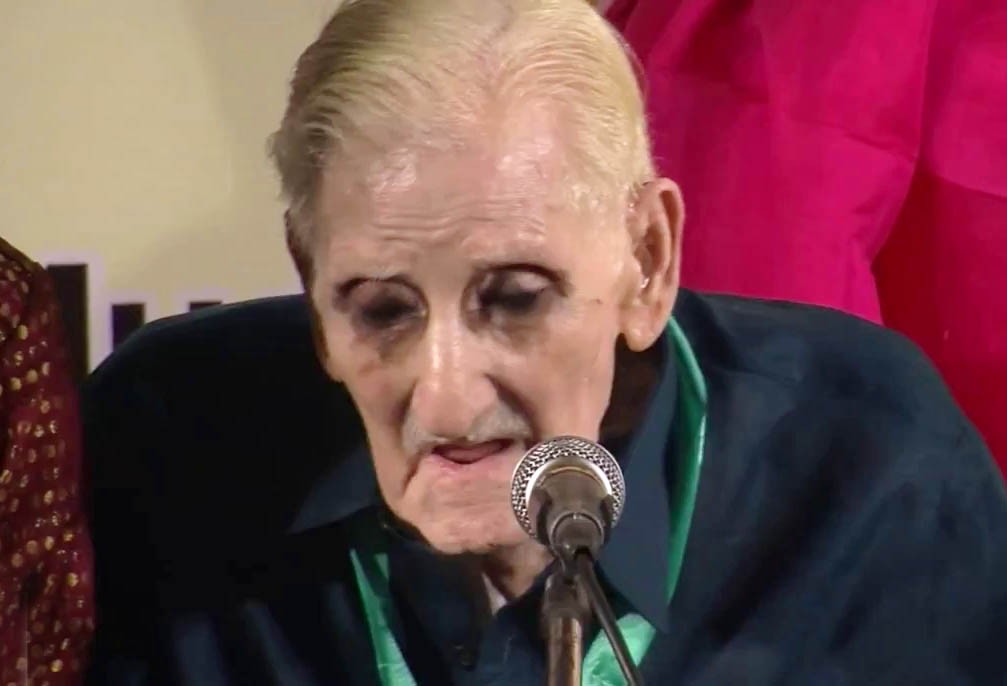
At Ustad Ghulam Hassan Shaggan’s first barsi, his grandson Muslim Shaggan gave an extraordinary performance

Barsis are usually occasions where musicians pay homage to the dear departed ustad with music. This very old tradition has been in practice and is considered to be the one of the indisputable rituals associated with the grand tradition of our music. But not all the known artistes who were supposed to perform turned up at the first barsi of Ustad Ghulam Hassan Shaggan held last week at the Alhamra which was rather surprising. But those who did perform, like Nadeem Riaz, Faheem Mazhar, Muslim Shaggan, Babar Ali, Mazhar Shaggan, Muhammad Riaz, Qadir Shaggan, Zoheb Hassan, Sunny, Jimmy and Muhammad Aslam, did so with the customary deference.
The brightest aspects of the entire evening were the two performances of Muhammad Muslim Shaggan, one as a solo and the other with his uncle. The son of Mazhar Shaggan and hence the grandson of Ustad Shaggan performed with lot of determined effort in the ang of his gharana and seemed to be in a position where he can be seen as the brightest prospect among the younger vocalists who as hereditary musicians have been carrying the tradition for generations. He is fast developing the craft required of a kheyal vocalist and very soon should be in a position to perform on his own.
These days, due to deference, he performs with his uncle Qadir Shaggan and is tentatively moving into the slot left vacant by the death of his grandfather. Ustad Shaggan all his life did not entertain the idea of switching over to more popular forms of music like many of the other gharana musicians. Some moved to dadra and thumri but finding few takers for that, shifted to ghazal and film music; some even relinquished their status as vocalists/instrumentalists and opted for the vocation of a composer, mostly for films besides radio and television.
But Ustad Shaggan did not budge from rendering the kheyal all his life with varying degree of reward and plenty of recognition, focusing on virtuosity of the full-throated taan, singing of the entire bandish -- meaning both the asthai and antara according to the rhythmic stresses of the taal, and expanding the raag according to the rules of the text book. He also had a very large repertoire and could sing many raags, most that were not sung at all or not very often. In his person, he was a treasure trove of raags and bandishes.
There was something about the gaiki of Ustad Shaggan that was very difficult to describe and lay one’s finger on. The rendition of the asthai and antara was more in the manner of dhrupad followed by the unfolding expansion of the raag more in the style of the kheyal, and the unleashing in the drut lai of lightening taans very peculiar to his own ang. There was less sensuousness in his gaiki, something which many other vocalists and musicians take great pride in. But the gaiki of those who followed the grand tradition as it emerged from the temple shunned sensuousness. The music of those who did not consider it to be an integral part of religious ritual was extremely appealing and engaged the listener. The latter was more intent on bringing forth the meditative dimension of music and serve as a means of inner exploration. It was not supposed to entertain and arouse but offer a certain type of tranquility that facilitated the gradual exploration more in the manner of a cold cerebral act.
Ustad Shaggan’s gaiki rested somewhere in the middle where the excessive sensuousness, at times bordering on sentimentality, was avoided deliberately and a more austere approach was evolved. This may appear contradictory in terms but all musical forms inspired by austerity, frugality and stoicism promoted otherworldliness compared to many who fostered greater sensuous engagement with the here and now.
No wonder the great vocalists found the gaiki of those aspiring to achieve a state of renunciation as too "rookhi", austere and bland while their own full of sensual delight. The latter was considered to be more appealing and engaging but this was not a question of being better or worse but of a worldview that garnered either engagement or denunciation. Ustad Shaggan’s music rested somewhere in the middle, and he was not the darling of those who desired the sensuality of the thumri or the lilting romance of the geet. Both these styles figured prominently in the popular forms of music in the subcontinent like thumri, dadra, geet, film geet and ghazal. It was also easier to consume these forms instantly.
On the occasion of the barsi, it was again announced by an official of the arts council that a welfare fund was being instituted to look after the artistes that otherwise were not getting the opportunities to perform given the very niche audience that classical music now had. Such announcements have been made from time to time, beginning from the highest office to the ones lower down, but it appears that the beneficiaries of the fund do not get enough compensation and are still dissatisfied -- growing larger in number and always asking for more. It could be much better if more music programmes are held in which these artistes get paid rather than being doled out money which makes them dependent and also probably creates an impression that they are on a pension not required to perform being past their prime.
Possibly, regular programmes can be held on the occasion of the barsis of the various ustads of the country that have left their indelible contributions. If these barsis are built into the annual calendar of programmes, of let us say the arts councils, these will create opportunities for artistes to perform and will also keep alive the ethos that is time honoured and is in line with the hallowed traditions that has characterised music practice in this part of the world.